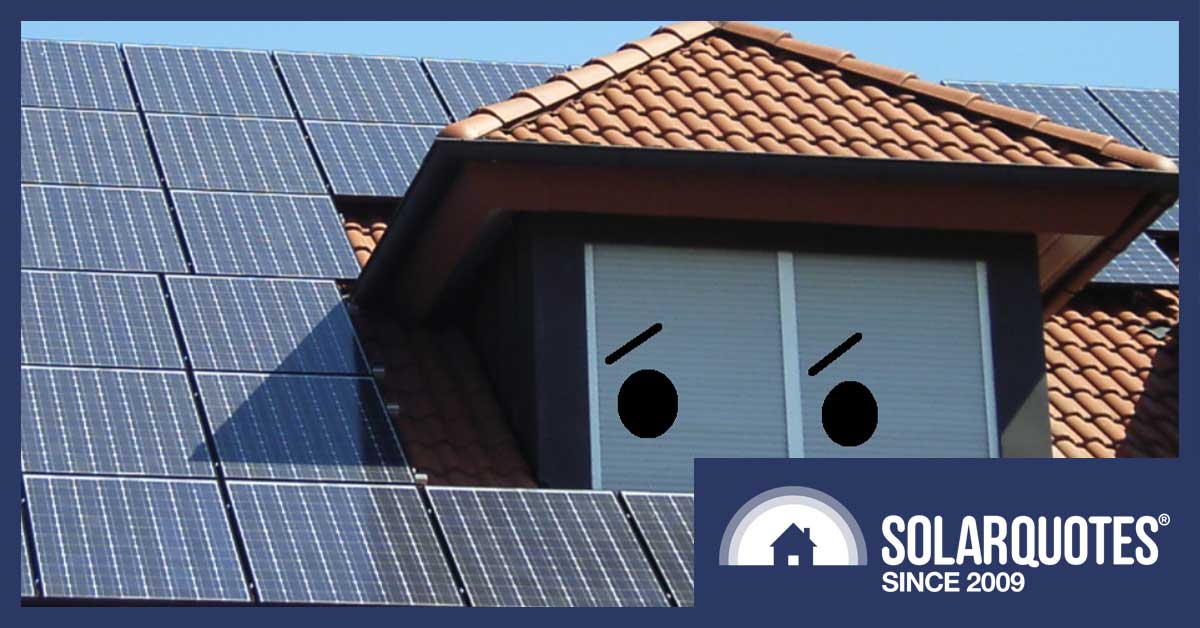
SMA’s ShadeFix doesn’t fix shade but reduces some of its secondary effects.
A couple of weeks go a reader asked me to write about ShadeFix. ShadeFix is the software German manufacturer SMA include in their solar inverters. This request made me feel a bit stupid because I had no idea what ShadeFix was. After a quick search I’d opened a dozen dozen browser windows about and decided there was plenty of information and it would be easy to write a quick, descriptive article about it.
I have come to rue this decision, as I neglected to check if there was any clear information on how well it performed. SMA gives the impression that it works very well without giving any information I could find clearly showing it does.
I asked SMA for help and was told they are publishing a paper on it later this month. But that could be over 3 weeks away which is too late for me. All the information I’ve researched so far will have dribbled out of my ears by then. Because I’m in a race against the memory leakage, I’ll tell you what I’ve learned so far and if new information turns up I’ll either update this article or write a whole new one.
ShadeFix Is SMA Inverter Software
ShadeFix is software inside all SMA inverters that operates automatically when in use. For the more technically minded, it is the algorithm that drives their Multi Power Point Tracker (MPPT). If you are interested in the details, Finn has previously written about how MPPTs work and why we need them.
If you have a mind as cunning as a fox, you’ve probably already guessed ShadeFix software is for fixing problems caused by shade. If you instead have a mind as cunning as a log, I’ll clue you in and tell you that it is for fixing problems caused by shade.
While SMA says ShadeFix is good at its job, I haven’t found any independent evidence indicating it performs as well as their videos or the information on their site suggests. German engineering has a pretty good reputation, so its easy for me to believe their ShadeFix software can the reduce secondary losses caused by shade. But I’m 100% certain it doesn’t do anything for the direct losses caused by shade, because nothing does.
Unfortunately, the SMA site doesn’t make this clear and anyone unfamiliar with how solar power systems work could easily come away with the impression they don’t need to worry about shade on their solar panels if they have an SMA solar inverter.
This has caused my opinion of SMA to decline. This is a pity because, if you can’t trust Germans, who can you trust? The Dutch?
Direct & Secondary Effects Of Shade
Shade on solar panels directly reduces power output because it directly reduces the amount of light falling on them — that’s what shade is. There are also secondary effects that can reduce output from unshaded solar cells in the shaded panel or from unshaded panels that are connected to the shaded panel.
The five options for reducing the secondary effects of shade are generally:
- Microinverters (Little inverters on the back of each solar panel that let them operate independently.)
- Optimisers (Little boxes of electronics on the back of solar panels that also let them operate independently.)
- Maxim optimised panels (Like having a built in optimizer but, hopefully, even better.)
- Shade tolerant panels such as SunPower’s P-series.
- Clever MPPT software in the solar inverter such as SMA’s ShadeFix.
But these only reduce losses from the secondary, additional, effects of shade.
Five options for dealing with the direct effects of shade are:
- Nothing
- Nada
- Zilch
- Zip
- Bugger all
There is nothing that can be done about the loss of electricity caused by less light falling on the solar panels. It doesn’t matter what fancy electronics are used, how advanced your software is, or if it was built by Montgomery Scott from the Starship Enterprise, you can’t change the laws of physics.
If shade reduces the amount of light falling on a solar panel by 50%, the reduction in its output will be at least 50%. All that can be done is get the losses as close to 50% as possible.
Because the makers of microinverters, optimisers, and solar inverter solutions like ShadeFix often don’t come clear about their products’ inability to do anything about direct losses from shade, many homeowners mistakenly think these products can solve their shade problems. But shade is solar panel kryptonite and there is nothing that stops it reducing solar energy output, apart from getting rid of the actual source of shade. As this may involve knocking down your neighbour’s home, cutting down local trees, or blowing the top off a mountain; it’s often frowned upon.

Kryptonite is the weakness of both Superman and Mulletman.
ShadeFix Is Not New
ShadeFix is not a new development. It’s been in SMA’s MPPTs since 2009. SMA just called it a different name — OptiTrac Global Peak Shade Mitigation. They recently changed it to ShadeFix, possibly because it’s less of a mouthful, or possibly because a dude with a ponytail in the Marketing Department though it was a good name. Their site says they have…
“…decided to reposition the feature in the market and give it the attention it deserves.”
So that might explain the name change.
How ShadeFix Works
SMA has a ShadeFix video that gives an explanation of how it works using gates and toy cars, but I don’t understand it at all. How does an inverter put gates inside a solar panel? Does it do it with a little robot arm? I simply don’t see how it can electronically affect what’s going on inside an individual shaded panel on a string.
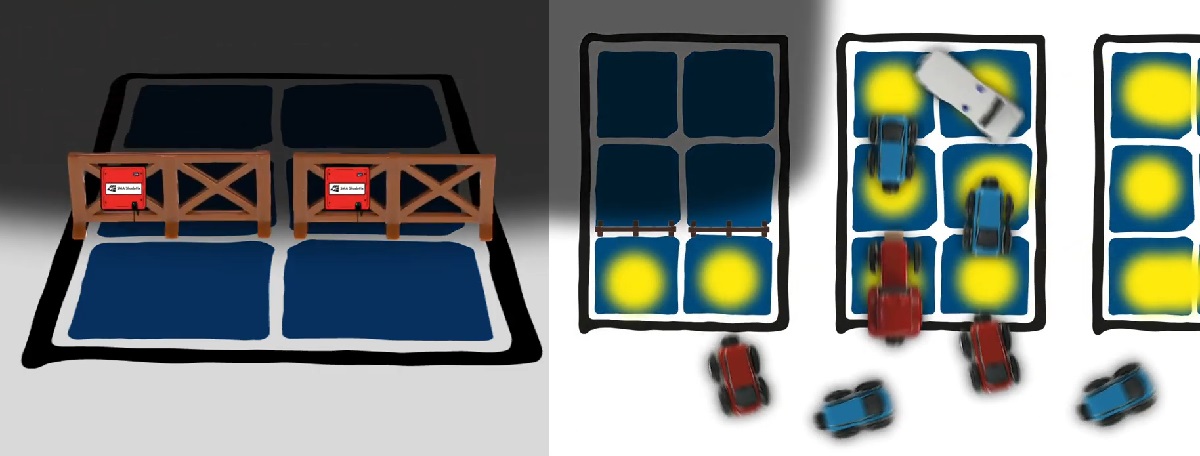
And who is driving the little cars? (Screenshots from SMA video)
Because the ShadeFix video is pretty useless and there isn’t much information on the main SMA site, I had to go looking for more information. Fortunately, I found this SMA document that gives an explanation of how OptiTrac/ShadeFix works. It has the following diagram showing 2 curves for a solar array:
- A blue curve at 2:00 pm when it’s unshaded, and…
- A red curve at 9:30 when it is shaded.
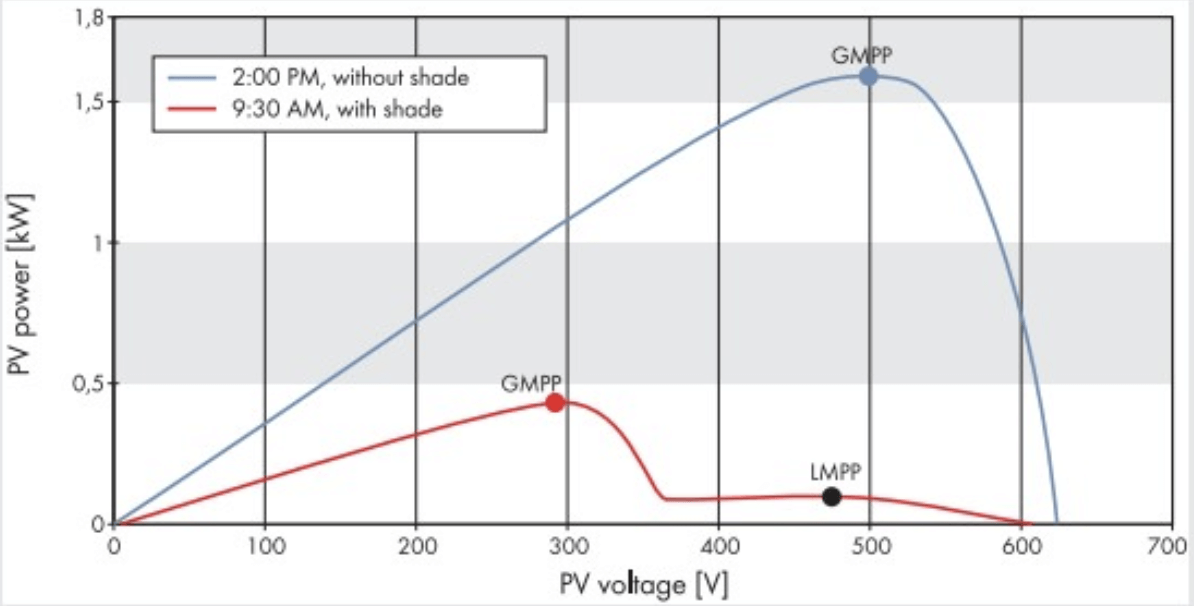
Image: SMA
At 2:00 pm all modern inverters will decide they can get the most power from the solar array at 500 volts, which is indicated by the highest point on the blue curve, the Global Maximum Power Point – marked as GMPP.
Note from Finn: A common algorithm used to find this GMPP is a ‘hill climb algorithm’. At its most basic this algorithm moves left (reduces voltage) until it sees the power decrease, then turns round and looks right (increases voltage) until it sees the power decrease. It then concludes the top of the hill, AKA the Maximum Power Point (MPP) is in the middle.
You might be wondering why it can’t just look at the curve and find the highest value. It doesn’t do that because it would take a long time to move through all the possible voltage values from 0 to 700 V, and for all that hunting time you would be losing power. Also the MPP is not static, it moves around all the time, so you want to ‘follow it around’ as efficiently as possible. In another life I programmed an advanced hill climb algorithm to track the maximum (optical) power point in fibre optic multiplexers.
The MPPT software simply looks for the highest point. But the red curve shows when shaded at 9:30 am, a solar inverter using a primitive algorithm could decide that 475 volts gives the maximum power point. But this point is only the Local Maximum Power Point, marked as LMPP on the red curve. If the algorithm looked further left towards 400 V it would see, after a small decline the power output increases towards 300 volts where the Global Maximum Power Point (GMPP) is hiding. But the primitive algorithm doesn’t venture that far and the inverter mistakenly thinks 475 volts is the best it can do. It gets stuck at a lower power output because it doesn’t bother to look far enough.
But the SMA software is a little more adventurous and so doesn’t get stuck in a rut. It will search far and wide for the point that will provide the most power and find the best voltage on the red curve is 295 volts and stay there. This will let it provide more power under shaded conditions than stupider solar inverters. The more involved search process does lose some energy as it hunts around at sub-optimal voltages, but SMA says this is small compared to the gains.
Pummeling A Perished Pony
Although I’m very confident this horse is dead, I’m still going to flog it a few more times and point out it doesn’t matter how well ShadeFix lets an SMA inverter choose the best voltage for maximum power output, it will do nothing to reduce the direct effects of shade. It can only reduce the secondary reductions in output caused by shade.
An Example Of An Under Performing Inverter
I found an example of a solar inverter failing to find the best voltage when solar panels are shaded on page 19 of this paper that describes a Fronius inverter getting stuck at “local max”, missing the higher power at the “Global max”. In this example a higher voltage is better than a lower one:
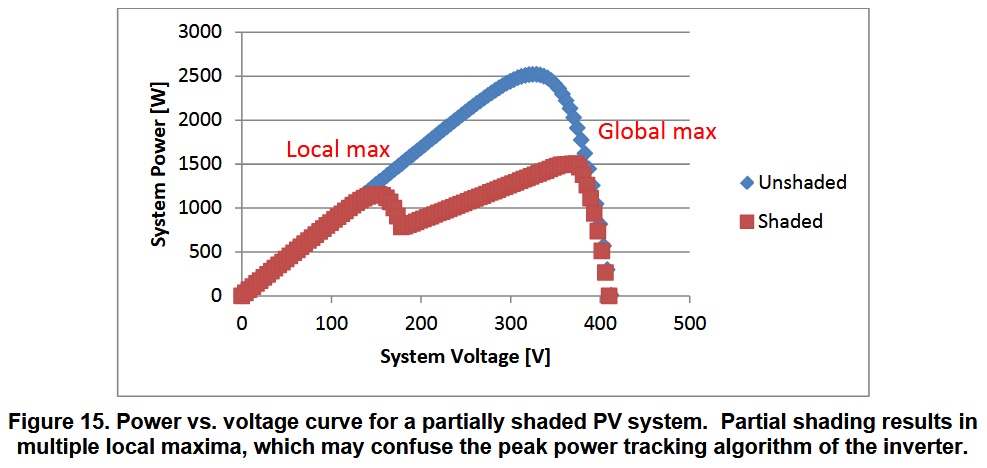
Image: NREL
This paper was published 9 years ago, so Fronius inverters have had plenty of time to get smarter. I don’t know much about programming, except it requires a lot of ones and zeros, but my guess is it wouldn’t be too hard for SMA’s competitors to copy their idea and ensure their solar inverters don’t get stuck at a sub-optimal voltage when solar panels are shaded.
Note from Finn: I’ve written a number of ‘advanced’ hill climb algorithms. They are not hard to implement. Heck, even I managed it. I’d be surprised if, in 2020, any decent brand of inverter uses primitive MPPT software that gets stuck on local maximums.
But no matter how fancy the software is, it can’t overcome the physical limits of inverters. As being able to operate at lower voltages appears useful for extracting the maximum amount of power under shaded conditions, I compared voltage operating range for a number of modern solar inverters and found SMA’s can can operate at a lower voltage than Fronius. But there are many that can operate at an even lower voltage than SMA, so if they had similarly capable software they may be able to do slightly better under shaded conditions.
How Much Extra Energy Will ShadeFix Provide?
If you want to know how much extra energy you’ll get from having ShadeFix, I’m afraid I can’t help you. I can’t find SMA giving that information anywhere. They say some stuff that sounds good, but don’t actually answer the question. For example, on this page Joachim Laschinski of SMA says…
“The annual yield of a lightly-shaded PV system with OptiTrac Global Peak is only around 1 percent lower than the yield of an unshaded system. For heavily shaded systems, this figure is around 3 percent.”
But without details we can’t draw any conclusions from this and, quite frankly, it sounds ridiculous. If a heavily shaded system is only producing 3% less energy than one that’s unshaded it means that shade must be only blocking 3% or less of the light falling on it. I wouldn’t call that heavily shaded, and if you do, I suggest you re-calibrate that term.
The ShadeFix video isn’t any help. All it does is provide is a picture of two test tubes, with one labeled ShadeFix having 20% more yellow in it. As there’s no information to put this into context it’s about as useful as large bulls on a nun:
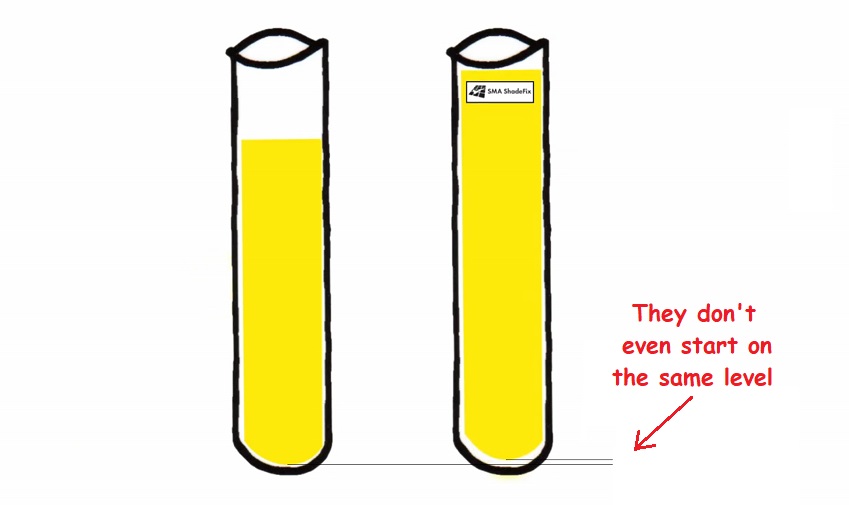
Image: SMA
An OptiTrac Global video from 2014 appears to go into more detail, but in the end we’re not really left with more information (UPDATE: the video is no longer available).
Towards the end of the video the narrator states:
“By virtually eliminating the negative effects of partial shading OptiTrac Global Peak closely mimics the production of an unshaded array.”
And this graph is presented:
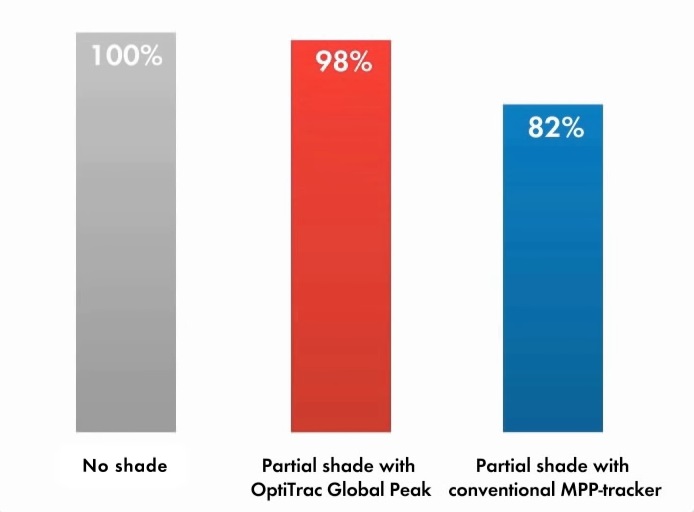
Image: SMA
But again, not enough information is given for us to know what is going on. All we can know for certain is the shade can’t have reduced the total amount of light falling on the solar panels by more than 2% if the OptiTrac system only had its output reduced by that much.
Third Party Testing
Because of the lack of information provided by SMA on the performance of OptiTrac/ShadeFix, I went looking for some independent information and after poking around on the internet (best to be careful when doing this because sometimes the internet pokes back) I found a report from SolarEdge where their inverter, which includes optimisers on each solar panel, was compared with Enphase microinverters and an SMA inverter. The report is not ideal because it’s from 2013 and doesn’t state the SMA inverter had OptiTrac. I assume there was a good chance it was present because OptiTrac came out in 2009, but I don’t actually know this. For all I know they went out of their way to use an SMA inverter without it.
The test used 3 different levels of partial shade1 falling on solar panels:
- Light: Total sunlight reduced 7% by shade.
- Moderate: Total sunlight reduced 15-19% by shade.
- Heavy: Total sunlight reduced by 25% by shade.
The shade was created by covering solar panels or parts of panels with a mesh cloth that blocked 36% of light. This is not very realistic because real shade is rarely constant like this and can easily cut light intensity by over 90%. Even very light foliage is likely to cut it by more than 36%. But unless I want to get off my arse and do my own testing, I guess I’ll have to settle for the information that’s provided.

Image: SolarEdge
According to the report the SolarEdge system, which has optimisers, had the best performance, with the Enphase microinverter system doing nearly as well. For the different shade conditions…
- Light: The SolarEdge inverter provided 1.9% more energy than the SMA inverter.
- Moderate: The SolarEdge inverter provided 5% more energy than the SMA inverter.
- Heavy: The SolarEdge inverter provided 8.4% more energy than the SMA inverter.
It’s not possible to conclude much from this, as it’s not certain the SMA inverter had OptiTrac and the results could be very different if more realistic shading had been used. But if OptiTrac was present it’s not a good sign that the SolarEdge system with optimisers and the Enphase microinverter system outperformed it.
ShadeFix Should Help With Secondary Shade Effects
If you get an SMA inverter ShadeFix will help with the secondary effects of shade, compared to a string inverter with a more basic MPPT algorithm, but how much is not clear. It will do nothing about the direct effects shade. While there is nothing that helps with this, apart from getting rid of the shade, SMA makes no attempt to explain this in any of their material I’ve seen. So, please remember that even SMA cannae change the laws of physics.
Footnotes
- The SMA paper says they used the procedure described in this paper, so I assume the percentages I give for the 3 levels are correct. ↩


 RSS - Posts
RSS - Posts



“after a small decline the voltage increases towards 500 where the Global Maximum Power Point (GMPP) is hiding”
Isn’t it actually hiding around 300v?
It is the LMPP which is near 500v, not the GMPP
Oops! Yes, thanks for catching that. I made the mistake, but then both Finn and I missed it in editing. That’s embarrassing. Good thing you noticed it, Richard. Fixed now.
Not well understood by many is that partial shading is responsible for potentially serious PV cell damage over time, including hot spot damage which can be terminal for solar modules.
The best strategy to avoid this type of condition happening, is to eliminated partial shading. Not an easy task.
Partial shading is different to full shading though. It is the differential effects of shading that can disrupt some cell junctions through brute electrical force.
Lawrence Coomber
I think all solar panels made in the last ten years have bypass diodes as standard, so hot spot damage is unlikely to occur. In fact, I can’t find any evidence of this ever occurring on any solar panels made in the last five years. Why is that?
“The five options for reducing the secondary effects of shade are generally:
6.) Husqvarna 120i
Best of five chainsaws I own.
Ron, it’s still 26 days to April 1.
The article referred to the SMA Shady Fing, and to the SolarEdge and Enphase individual panel systems, for dealing with shade, but, does not include what I assume to be a fairly recent development, where I believe that some sting inverters are kind of hybrids between these different systems, where, on some string inverters, apparently, provision exists, for part of their connected panels (e.g., about 4 or 6 panels, or, some similar number), to have optimisers fitted and operational on them, with all of the other panels connected to the applicable hybrid string inverters, being bog standard panels, without optimisers, to deal with partial shading; in that some of the panels connected to the inverters, are affected by shade, and so, have optimisers, but, the other panels connected to the inverter, do not become shaded, so, not needing to be isolated by using optimisers, do not have them.
How do those hybrid inverters (not the so-named “hybrid inverters” that also incorporate battery management), fit into the scheme of things – including effectiveness, cost, and, feasibility, as applicable in the article above?
Hi Bret
What you are describing sounds like the SolarEdge system which consists of a string inverter plus SolarEdge optimisers on each panel. My understanding is its output is similar to using microinverters or a similarly efficient string inverter with optimisers.
No – Ronald.
A while ago, I was given quotes for systems with string inverters, where, out of 20-24 panels, 4-6 of the panels would have optimisers fitted, to deal with shading for only the 4-6 panels, and, all of the other panels would not have optimisers.
The inverter brand(s) did not include SolarEdge.
Due to the bodgy way quotes are given by some companies, I think these quotes were spoken ones, as some companies charge anything up to a 20% increase in price, when written quotes are requested.
I do not remember which company, and which brand(s) of inverters apparently had the functionality of this partial use of optimisers in a string inverter system.
This is one of the reasons that the CEC need to be sacked, and, replaced with something that mandatorily requires proper procedures and standards, of photovoltaic systems retailers and salespeople, and installers, and, why, as it stands, the industry is, overall, shonky.
And, this is why consumer representation needs to be part of the governing board of whatever entity controls accreditation of photovoltaic systems retailers, salespeople, and installers, to weed out the crooks. At present, nobody cares about the consumers and consumer protection; it is very much, “caveat emptor”.
In this case, my expectation would be — provided all shade affected panels have optimisers — is output would be similar to an unshaded system minus insolation losses due to shade. That is, if shade blocks 4% of the light falling on the panels then the system output would be a little less than 96% that of an unshaded system.
Hauwei have such a system with inverter and optimisers and Tigo have such an optimiser as well that can work with any inverter. The thing to remember is that panels have diodes in them so that often a partially shaded panel will mean that panel produces nothing while it is shaded, but won’t reduce the output of the rest of the panels, but if all panels are shaded then they will all prudence a reduced output (and there is nothing an optimiser can do about it). So while optimiser panels can be helpful to produce maximum output as it will allow those partially shaded panels to keep producing while they are shaded, they are rarely a necessity and may not always be worth the money even when there is shade. Obviously this varies a lot depending on individual situations though.
Brett; you said:
“A while ago, I was given quotes for systems with string inverters, where, out of 20-24 panels, 4-6 of the panels would have optimisers fitted,”
But you haven’t got the quotes! And by your own admission you are just guessing the details!
How does this slack attitude of yours in not insisting on a properly prepared and written quote, help improve the industry standards from slipping, which you went on to condemn.
Your attitude about the mystery quote, was no better than the mystery person who gave it to you supposedly.
Lawrence Coomber
I’m with Ronald – you only need to fit optimisers to those panels that are (or will be) impacted by shade – then those shaded panels will have less (secondary) impact on the other, never shaded, panels in the string.
Inerestingly, we have a 3phase SMA inverter, circa 2015, and I have always wondered why one string showed a much higher voltage in the early morning than I would expect (when the sun was beginning to peek over and sweep across a distant tree-line – falling directly on the upper row of panels but more erratically on the panels) – when my experiments on a single small panel would show the MPP voltage MUST drop for UNIFORMLY less light falling on it.
Thanks Ronald – you have answered my concern about the functioning of this MPPT.
I have wondered about fitting optimisers to some of the panels of our 2nd string, which is heavily impacted by shade from a neighbour’s tree, but Only in winter, howevet I don’t think we would recover the costs involved (and we can hardly use option 6, the Husqvana option!) – so we will just have to live with it.
Correction
… more erratically on the LOWER panels…
“I found a report from SolarEdge where their inverter, which includes optimisers on each solar panel, was compared with Enphase microinverters and an SMA inverter. The report is not ideal because it’s from 2013 and doesn’t state the SMA inverter had OptiTrac. I assume there was a good chance it was present because OptiTrac came out in 2009, but I don’t actually know this. For all I know they went out of their way to use an SMA inverter without it.”
From memory, OptiTrac wasn’t enabled by default. At least in the early days, it had to be selected as the preferred MPPT algorithm mode. Would you like to bet that in this comparative performance test SolarEdge didn’t operate the SMA inverter with this mode selected?
The PDF: https://www.sma.de/fileadmin/content/global/specials/documents/ShadeFix/SMAShadeFix-TI-en-10.pdf
http://www.smainverted.com/new-university-study-shows-sma-outperforms-the-competition/
I find SMA much more expensive than the Chinese brands.
Reaction from Solar Edge about the SMA’s optimizer study:
https://www.solarpowerworldonline.com/2020/04/solaredge-takes-issue-sma-inverter-study/
Interesting. I wrote about Toke Franke’s Danish study here:
https://www.solarquotes.com.au/blog/panel-optimisers-danish-study/
Dear Ronald,
please let me know if you got any additional information about the ShadeFix system from SMA or you found third party testing results where the system was used (I’ve already read about SolarEdge test)?
I am curious if this inverter actually allows for yield optimization (of course I mean the second effect).
Kind reagrds,
Krzysztof Kucharski
Poland
Since 12 january this year, I’ve got solar panels on my roof (Longi) and was adviced to choose for SMA. After installation I saw that the two fake chimneys would give shade on the most left and most right panel of the upper row.
So I said to the installer to lower all the panels about 30 cm. That is possible. But he told me that SMA had Shadefix and that was not necessary.
So I’m very interested in what this function really delivers.
I’m too sceptical because shade means a fall back of the total string and I have no idea how the Inverter can solve this at the end of the string.
I’m afraid there is only a limited ability for any string inverter to mitigate the effects of shade, no matter how good it is at it. You may wish to check how much the shade is reducing the output. This site is very useful:
https://solcast.com/rooftop-solar/free-pv-system-performance-estimation-tool/
It will give an estimate of how many kilowatt-hours the system should have produced recently based on local weather conditions.
Since all panels in a string carry the same current, the power is limited by the shaded panel which can for instance only deliver half of the current. That would mean the entire string delivers 50% of the power of an unshaded string. If you try to increase the current (that is what the MPPT does) you notice directly that the voltage drops quickly caused by the one shaded panel. If you would however keep increasing the current, the voltage over the panel would become zero at which point a reverse protection diode kicks in and the current can increase further. At this point the panel is shorted and does not deliver any power.
Example: if you have a string of 10 panels and only one is shaded, you can force the maximum current again and disable that one panel completely. That’s still 90% of the power. With less panels the cost of disabling one becomes more expensive. A power optimizer or micro converter is better as it matches all panels to the same current (optimizers) or the same voltage (micro inverters). Each panel can deliver all it’s power even if that is different from another panel in the string.
You could achieve the same by placing all panels in parallel. Drawback is that the total current would become very high resulting in much more cable loss.
What do you think of the panels that are divided so that shade on one part doesn’t affect the output of the whole panel? Do they work efficiently enough for the cost?
They can slightly better handle shade, but the effect is small so — all else equal — it wouldn’t be worth paying a large premium. But these are becoming more common and there may not be much of a premium over panels of otherwise comparable quality.
I have panel level Tigo Optimizers, should I turn off the ShadFix option on my SMA Inverter or keep it on? It’s on by default. Thank you.
That’s a good question. I doubt it would do any harm to have it on. But if you want to be sure you could contact SMA. I’d be interested to hear what they say if they respond. You could also ask Tigo, but they may not have information on ShadFix. One option would be to turn it off and see what happens, but I think any effect would be so small it would be hard to notice.